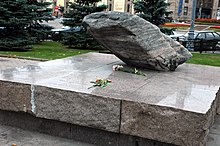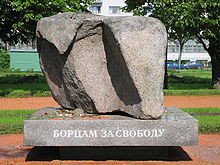This is an old revision of this page, as edited by Alex Bakharev (talk | contribs) at 05:07, 28 March 2009 (put a ref to the meaning of the acronym). The present address (URL) is a permanent link to this revision, which may differ significantly from the current revision.
Revision as of 05:07, 28 March 2009 by Alex Bakharev (talk | contribs) (put a ref to the meaning of the acronym)(diff) ← Previous revision | Latest revision (diff) | Newer revision → (diff)
The Solovki prison camp (later Solovki prison) was located on the Solovetsky Islands, in the White Sea). It was the "mother of the GULAG" according to Aleksandr Solzhenitsyn. Historically Solovetsky Islands have been the location of the famous Russian Orthodox Solovetsky Monastery complex, which repelled foreign attacks during the Time of Troubles, the Crimean War, and the Russian Civil War.
By Lenin's decree, the monastery buildings were turned into Solovetsky Lager' Osobogo Naznachenia (SLON), that is, the "Solovki Special Purpose Camp". The acronym of the camp name is a sullen word play for those who speak Russian: slon means "elephant". It was one of the first "corrective labor camps", a prototype of the Gulag system.
In 1926 the Solovki camp was turned into a prison, partly because of the conditions which made escape near impossible and partly because the monastery had been used as a political prison by the Russian imperial administration. The treatment of the prisoners attracted much criticism in Western Europe and the USA. After a thorough cleanup, the Soviet government sent the proletarian writer Maksim Gorky to the camp in an attempt to counter this criticism. Indeed, Gorky wrote a very favourable essay, which praised the beautiful nature of the islands. How much Gorky knew about the real conditions, remains a mystery.
The prison was closed in 1939 because the Second World War was imminent, while the camp was situated close to the border with Finland. The buildings were then transformed into a naval base. The Orthodox Church reestablished the monastery in 1992, the year when the ensemble was included into UNESCO's World Heritage List.
Notable prisoners


Many prisoners were members of the intelligentsia, and represent the cream of Tsarist and revolutionary-period Russia. These include:
- Professor A.E.Anisimov - art critic
- I.P.Antsiferov - historian
- V.A.Artemyev - inventor
- Professor S.A.Askoldov
- V.W.Bakhton - inventor
- Vladimir N. Beneshevich - historian, paleographer
- A.V.Bobrishev-Pushkin - descendant of Decembrist Pavel Sergeievich Bobrishev-Pushkin
- I.E.Braz - artist
- Pavel Alexandrovich Florensky - priest, scientist, encyclopaedist
- G.J.Gordon - historian
- A.K.Gorsky - poet
- Archimandrite Illarion (Troitsky) - Professor of the Moscow Theological Academy
- Academician D.S.Likhatchev - philologist
- I.V. Popov - Professor of the Moscow Theological Academy
- H.H.Vinogradov - ethnographer
- O.V.Volkov - writer
- M.N.Voronoy - poet
Naftaly Frenkel was at first a prisoner, but later became commander of the camp.
Solovki camp in art and literature
- Aleksandr Solzhenitsyn spends a great deal of Part III of The Gulag Archipelago discussing the development of Solovki and the conditions there during the early Soviet regime.
- The fictional town of Solovets in Monday Begins on Saturday is a hint at Solovetsky Monastery.
- In The Master and Margarita by Mikhail Bulgakov, Ivan Ponyrov (the poet also known as Ivan Homeless) suggests to Woland (a German name for Satan) that Immanuel Kant should be sent to Solovki as punishment for his attempts to prove the existence of God. Woland replies "Thats just the place for him! I told him so that day at breakfast... It is impossible to send him to Solovki for the simple reason that he has resided for the past hundred-odd years in places considerably more remote than Solovki, and, I assure you, it is quite impossible to get him out of there."
- Marina Goldovskaya's 1987 documentary film Solovky Power explores the camp at Solovki and its status as the first of the Soviet labour camps. It features interviews with former prisoners, including D. S. Likhachev.
References
- Соловецкий Лагерь Особого Назначения (СЛОН) Template:Ru icon
- Gulag by Anne Applebaum. New York: Anchor Book, 2003. p.20.
- Application for UNESCO World Heritage Site, 1991, p. 11.
External links
- Solovki Information Portal
- Baron, Nick. Production and Terror: The Operation of the Karelian GULAG, 1933—1939, Cahiers du Monde russe, 43/1, Janvier-mars 2002, pp. 139-180.
- Jakobson, Micheal. Origins of the GULAG: The Soviet Prison Camp System, 1917-1934, University Press of Kentucky, 1993.ISBN 0-813-11796-8. Available on Google Books
- Labor Camp Socialism: The Gulag in the Soviet Totalitarian System by Galina Mikhaĭlovna Ivanova, Carol Apollonio Flath, Donald J. Raleigh, Translated by Carol Apollonio Flath, published by M.E. Sharpe, 2000. ISBN 0765604264. Available on Google Books
- Forced Labor Camps Open Society Archives
- History and Photos (in Russian)